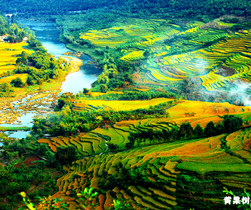Home> Attractions
Ming village fortress
(Beijign today)
Updated: 2007-04-02
The tunpu (village fortress) in Anshun, Guizhou, was built in the Ming Dynasty (1368-1644) for military use. Today, it retains its original style and pace of life.
History
Originally constructed in the Ming Dynasty as fortresses, tunpus, echo a certain military function.
When the first Ming emperor, Zhu Yuanzhang, came to power, the army and locals in Anshun constructed villages as military sites. Each village included forts, sentries and toll gates.
In those days, soldiers spent most of their days working as farmers. It was only in times of war that they were called to unify and repel an enemy. People living in the tunpus were forbidden to marry people of other ancestries. Even after the passage of hundreds of years, residents of the tunpu retain their traditional Ming lifestyles, clothing and hair styles.

Main tunpu
Tianlong Tunpu
The most popular destination for tunpu tourists in Anshun is Tianlong tunpu. Since the Yuan Dynasty (1271-1368), Tianlong has been the tunpu with the most armies and post houses.
A Ming-style teahouse is located at the entrance of the village. Waitresses there dress in Fengyang Han clothes, a style of clothing which originated in the Ming period, and is named after Zhu Yuanzhang's hometown, Fengyang County, Anhui. A performance hall is lcated behind the teahouse. Visitors can see local performances there.
Entering the lanes of the village, you will see barracks. Jiudaokan Lane is typical of the village, because it crosses through a narrow, low gate porch with fire holes along the walls.
The mountains around the Tianlong tunpu are almost an archive of historical buildings. Ancient ramparts and the castle-style Wulong Temple are all national cultural relics. A Ming-era factory where soldiers produced weapons is in the rear of the mountain. Beacon towers, battlements and sentry posts dot the landscape.
Yunfeng Tunpu
Yunfeng tunpu is the most complete military defense post, built with stone gates and towers.
Yunshan tun is one of the spots. It is located in the canyons of the Yunjiu Mountain. The only way into the village is a twisting, stony stairway. Long walls were built besides the gate to connect it into the cliffs of the mountain.
A stony main street crosses the village from east to west. There are drama stages, a temple to the God of Wealth, ancestral temples and traditional Chinese medicine stores.
Residences and blockhouses are connected by twisting lanes and built into the mountain. The tunpu is built to be an ironclad defense.

